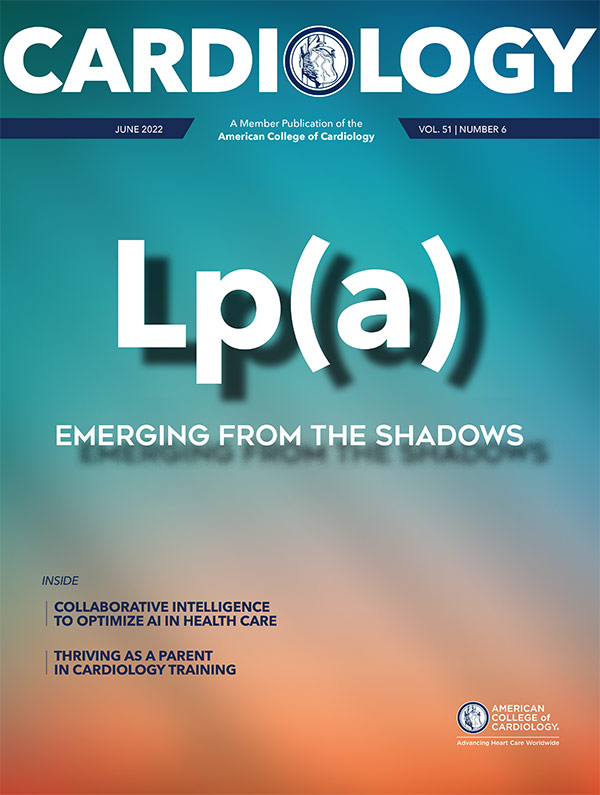Focus on EP | Heart Rhythm 2022: My Top Five

The Heart Rhythm (HR) 2022 conference returned to San Francisco last month, with the number of attendees more reminiscent of gatherings from the pre-Covid era. Like so many of my colleagues, I was eager to hear the latest science amongst my colleagues. Here are my top five takeaways.
1
Enthusiasm peaks for in-person attendance.
The first day of the conference resembled a day at Disney World: attendees waited in one long line to have their vaccination status validated, then in another long line to have their registration badge printed, and finally went to a third area to pick up a color-coded lanyard that signified their degree of interest in social interaction. The green lanyards, indicating comfort with hugs and handshakes, were incredibly popular while barely anyone took the red lanyards, reflecting a preference for more distant social interaction. The sessions for late-breaking clinical trials quickly reached maximum room capacity and security officials frequently closed the doors to prevent overcrowding. At the conclusion of each day's sessions, there was a mass exodus of attendees to the nearby bars and restaurants where cocktails were enjoyed with conversations about the future of electrophysiology (EP). For the first time since May 2019, when the conference was last held in San Francisco, attendees finally seemed comfortable returning to a state of social normalcy.
2
Electrophysiologists do not always see eye to eye.
A live debate between Vivek Reddy, MD, the principal investigator of the landmark trials for percutaneous left atrial appendage closure (LAAC) in patients with atrial fibrillation (AFib), and John Mandrola, MD, FACC, a longstanding outspoken critic of LAAC, was the first major event of HR 2022. Despite reviewing the same safety and efficacy data regarding LAAC, the viewpoints of these two individuals could not have been more divergent. Reddy argued that LAAC was not only comparable to oral anticoagulation use for the combined endpoint of ischemic strokes, hemorrhagic strokes, major bleeding and mortality, but may also be associated with a reduction in stroke severity. Mandrola questioned the methodology and reporting of LAAC clinical trial data and insisted that a more ideal clinical trial be conducted to ascertain the noninferiority of LAAC relative to oral anticoagulation. During the debate, Twitter feeds erupted with additional opinions from the EP community. There was expectedly no resolution to these differing opinions, and like many debates in the EP field, Reddy and Mandrola simply agreed to disagree.
3
In the right patient population, ablate AFib sooner and faster.
Over the last several years, the trend in AFib management has increasingly favored early rhythm control (ERC) utilizing an ablation strategy. At HR 2022, three late-breaking clinical trials further investigated how the timing of ablation could be optimized. The ER2EP study compared AFib management in 400 emergency department patients with new-onset AFib who underwent either routine care (200 patients) or care guided by an EP service (200 patients). The additional involvement of the EP service led to a shorter time to oral anticoagulation initiation (1.7 vs. 17 days; p<0.001), shorter time to antiarrhythmic medication initiation (2.6 vs. 25 days; p<0.001) and shorter time to ablation (52.8 vs. 180.6 days; p<0.001). The length of stay was also shorter when EP service was involved (2.35 vs. 5.84 days; p<0.001).1
A subanalysis of the EAST-AFNET 4 trial showed that ERC, compared with usual care, led to a reduction in the composite outcome of cardiovascular death, stroke and hospitalization for worsening heart failure or acute coronary syndrome in 1,093 AFib patients with a CHA2DS2-VASc score ≥4 (5.5 events per 100 patient-years vs. 8.4 events per 100 patient-years; p<0.001) but not in 1,696 AFib patients with a CHA2DS2-VASc score <4 (3.0 events per 100 patient-years vs. 3.2 events per 100 patient-years; p<0.56). There was also no significant difference in outcome when patients were stratified by age (<65 years vs. 65-74 years vs. ≥74 years).2
The Short-AF study compared 29 patients who underwent pulmonary vein isolation (PVI) with high power RFA (50 watts) to 31 patients who underwent PVI with standard power RFA (25-30 watts). Those in the high power RFA group required less time to achieve PVI (87 vs. 126 minutes; p=0.003) and experienced less AFib/atrial flutter recurrence at one-year follow-up (10% vs. 35%; p=0.032). There were no significant adverse events in either group, but there was a trend towards more silent cerebral embolic events in the high-power RFA group, compared with the standard-power RFA group (40% vs. 17%; p=0.053).3
4
Conduction system pacing continues to impress.
Conduction system pacing (CSP), which includes both His bundle pacing and left bundle branch pacing (LBBP), has not only become an alternative to traditional biventricular pacing (BVP) but also emerged as a replacement for BVP in patients who are indicated for CRT. Three late-breaking clinical trials further supported this notion.
The Rescue LBB Area Pacing for Coronary Sinus Lead Failure of Non-Response to BIV-CRT study demonstrated a significant narrowing of pre- to post-procedure QRS duration (170 ms vs. 139 ms; p<0.001) and improvement in pre- to post-procedure left ventricular ejection fraction (LVEF; 29% vs. 40%; p<0.001) in 200 patients who underwent LBBP after BVP failed (either from coronary venous lead complications or no response).4
The Clinical Outcomes of Conduction System Pacing Compared to Biventricular Pacing In Patients Requiring CRT study evaluated 219 patients who underwent BVP and 258 patients who underwent CSP. Compared with patients in the BVP group, those in the CSP group experienced a narrower paced QRS (133 ms vs. 154 ms; p<0.001), greater improvement in LVEF (39.7% vs. 33.1%; p<0.001) and a lower rate of death or heart failure hospitalization (28.3% vs. 38.4%; p=0.013).5
The LBB Pacing vs. Biventricular Pacing in CRT trial randomized 40 patients with nonischemic cardiomyopathy and LBB block to either LBBP or BVP. Assessment of LVEF at six months after CRT demonstrated a greater improvement in LVEF in those who underwent LBBP compared with those who underwent BVP (21.1% vs. 15.6%, p=0.039).6
5
Pulse field ablation is around the corner.
For the second consecutive year, there were no late-breaking clinical trials related to pulse field ablation (PFA). However, there was no shortage of PFA discussion throughout the remainder of the conference as this emerging technology was described for experimental use beyond the pulmonary veins for patients with persistent AFib (involving posterior wall isolation and additional linear lesion ablation) and for patients with ventricular arrhythmias. In the technology suites of the exhibit hall, all the major EP vendors were showcasing the development of their own PFA systems. Expect heavy PFA representation at the HR 2023 conference in New Orleans as the four ongoing PFA clinical trials are expected to conclude within the next year: PULSED AF with Medtronic, ADVENT with Farapulse/Boston Scientific, inspIRE with Biosense Webster, and PFA-AF with Acutus Medical.
References
- Cardiovascular Business. New-look protocol boosts outcomes among AFib patients in the ER. May 2, 2022. Available here.
- IDW Online. Subanalysis of the EAST - AFNET 4 trial: Patients with AF and high comorbidity burden benefit from early rhythm control. April 29, 2022. Available here.
- Cardiovascular Business. High power vs. standard RF ablation leads to improved pulmonary vein isolation, shorter procedures. May 2, 2022. Available here.
- Vijayaraman P, Herweg B, Verma A, et al. Rescue left bundle branch area pacing in coronary venous lead failure or non-response to biventricular pacing: Results from International LBBAP Collaborative Study Group. Heart Rhythm 2022;Apr 27:S1547-5271(22)01948-8.
- Vijayaraman P, Zalavadia D, Haseeb A, et al. Clinical outcomes of conduction system pacing compared to biventricular pacing in patients requiring cardiac resynchronization therapy. Heart Rhythm 2022;Apr 26:S1547-5271(22)01947-6
- tctMD. Evidence grows for conduction-system pacing as an alternative to CRT. May 5, 2022. Available here.
Clinical Topics: Acute Coronary Syndromes, Anticoagulation Management, Arrhythmias and Clinical EP, Cardiovascular Care Team, Geriatric Cardiology, Heart Failure and Cardiomyopathies, Prevention, Anticoagulation Management and ACS, Anticoagulation Management and Atrial Fibrillation, Implantable Devices, EP Basic Science, SCD/Ventricular Arrhythmias, Atrial Fibrillation/Supraventricular Arrhythmias, Acute Heart Failure
Keywords: ACC Publications, Cardiology Magazine, Aged, Stroke Volume, Atrial Fibrillation, Immunodeficiency Virus, Bovine, Pulmonary Veins, Cardiac Resynchronization Therapy, Follow-Up Studies, Acute Coronary Syndrome, Atrial Appendage, Atrial Flutter, Brain Ischemia, Bundle of His, Cardiovascular Diseases, Coronary Sinus, Hemorrhagic Stroke, Inpatients, Length of Stay, New Orleans, Restaurants, San Francisco, Social Interaction, Social Media, Ventricular Function, Left, Stroke, Heart Failure, Electrophysiology, Ischemic Stroke, Anticoagulants, Cardiomyopathies, Vaccination, Cardiology, Technology
< Back to Listings

